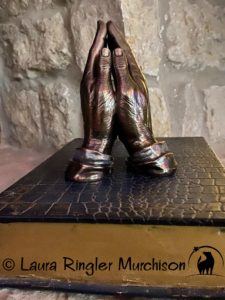
Growing up in our little apartment my mother kept out several things I distinctly remember. On her baby grand piano there was my baby picture flanked by my bronzed baby shoes, and a set of bronze praying hands. Over the years my baby picture was replaced with older ones of me as I grew and my bronzed baby shoes were packed away. Those praying hands, though, never left. They were a constant throughout my entire childhood. Normally I dislike detached body parts (like busts) but there was something about seeing those hands cupped together and tilted slightly upward in prayer that never failed to move me. Despite looking slightly masculine in nature, I imagined they still could have belonged to either a man or a woman. It seemed to me they were made from a kneeling position, allowing the layered cuffs around them to fall gently back in order to better offer themselves to God. Recently I came across this small pair pictured above in a catalogue. I had told my husband how much I’d always loved my folks’ praying hands and he and our little girl surprised me with them as a gift for Mother’s Day. They now lovingly reside on our den table so that every time we sit on our sofa we can see them and can be reminded. Prayer takes many forms: thanksgiving, worship, confession, and supplication are the ones I tend to use most often. Mahatma Gandhi said, “Prayer is the key of the morning and the bolt of the evening.” When I came across that it made me think of the Episcopal practice of saying morning and evening prayers. I confess I am enjoying being able to participate in morning prayers now from the comfort of home. I like to see that as one positive of this Covid-19 virus. I was never able to make daily prayers at church and now I can even play them back if I choose. Both Eastern and Western Christian churches (Orthodox, Anglican, Catholic, Assyrian, Lutheran and some other Protestant denominations) still practice the Liturgy of the Hours (multiple prayers said daily.) This grew from the Jewish practice of reciting prayers at set times of the day known as zmanim (literally “hours” in Hebrew.) Matins (“morning” in French,) Lauds (prayers at dawn,) Prime (the first hour of prayer,) Terce (mid-morning,) Sext (midday,) None (mid-afternoon,) Vespers (“at the lighting of the lamps” in late afternoon,) and Compline (the last prayer said before bed.) There are five daily prayers prescribed in Islam. To this day, one of my fondest memories is of hearing the Muslim call to prayer sung and projected throughout the medina during Ramadan while we were in Tangiers. I know Hindus and Buddhists have daily mantras and meditations as well. Even those who are not religious can be seen clasping their hands together at times. For me the praying hands are a symbol of hope, gratitude, solace, praise, and peace. As my daughter grows up I hope she will view praying hands in much the same way I did. They serve as a reminder that prayer is both an opening of the heart and a closing of worry … the key and the bolt.
